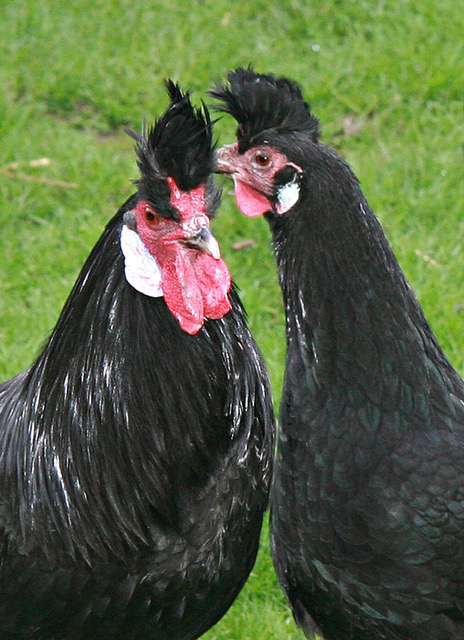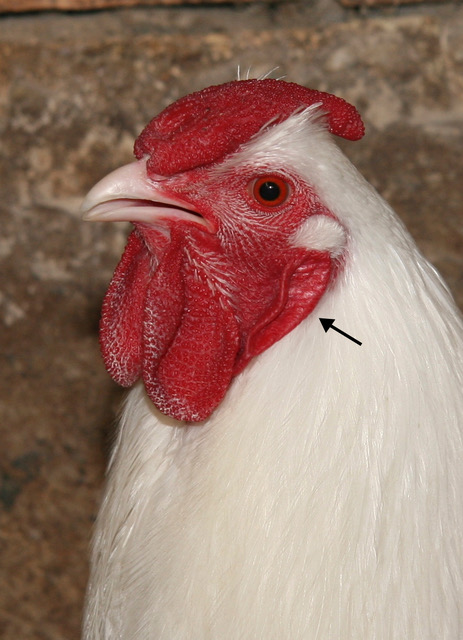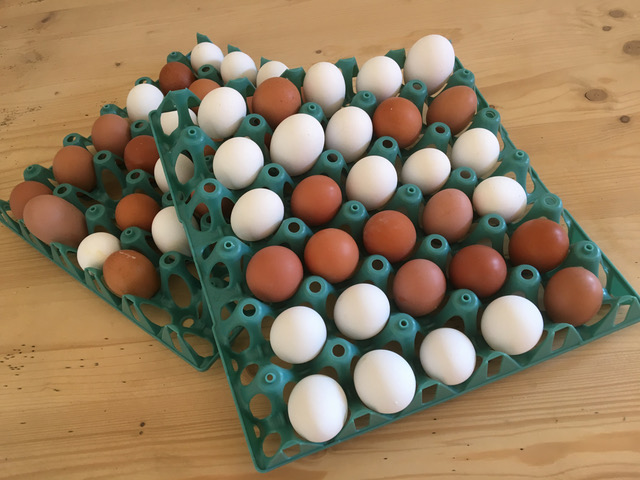Marvellous hen’s egg
The only animal product pre-packaged by nature
by Heini Hofmann
Farm animals provide us humans with food such as meat, milk and honey, but we have to obtain, portion and package them ourselves. It is different with the egg: The egg is conditioned by the chicken and delivered ready for transport in a distinctly coloured shell, a bio-packaged design product of nature, so to speak, around which many myths have grown.
Of over 1.59 billion eggs (shell eggs and egg products) consumed in Switzerland in 2019, more than half are domestically produced, increasing the degree of self-sufficiency to 63%. Per capita consumption in 2019 was an astonishing 184.4 eggs. Reason enough to think about this food miracle, which has become an integral part of our diet, when you hit the edge of the frying pan or tap it on the egg cup.
How an egg is made
The process of egg formation takes about 24 hours, which also means that a hen cannot lay more than one egg per day. The “biological production line” leads from the hen’s ovary, where the egg cell of the yolk is deposited in a spherical form, through the fallopian tube or “laying gut” to the egg outlet via the cloaca, with the vagina being pulled over it to keep the egg clean. At the top, in the fallopian tube funnel, the egg would be fertilised by the sperm of the cock, if it was about breeding and not, as here, about consumption eggs.
In the fallopian tube, the egg albumen (vernacular: “egg white”) is attached to the developing egg, which occurs evenly because the egg rotates around its own axis in the fallopian tube. At the same time, the contractions of the fallopian tube give the egg its shape with a pointed and blunt end. This trick of nature was not invented for Easter egg tapping, but for a problem-free laying process and a space-saving arrangement during incubation. It also prevents the eggs from rolling straight ahead, which can prevent disaster for birds breeding on cliffs.
Fragile shell?
In contrast to reptiles, whose eggs are enclosed by a leathery skin, evolution has provided a solid calcareous shell for birds’ eggs, through whose pores – thanks to the protective, waxy shell skin – oxygen but not germs can enter the egg. Are eggs fragile structures? Depending on your point of view: The shell thickness is only 0.3 to 0.4 mm (compared to 2 mm for ostriches), which makes the egg clearly vulnerable. That is why Christopher Columbus’ boyish trick of putting an egg on its tip by tapping it worked out.
However, the layered structure of the egg shell and the crystal structure of the calcium (94% calcium carbonate) guarantee unexpected firmness of the seemingly fragile construction.
This is because to push in an egg from the tip, a load of two to three kilo-newton is necessary. It can also withstand an artificially generated internal pressure of 2.5 atmospheres. Therefore, before hatching, a chick can only open the shell from the inside with a trick, by scratching the shell with the egg tooth sitting on the tip of the upper beak – like a diamond – and then prying it open with the body thanks to the notch effect.
Brown eggs are not healthier
The usual quiz question “Who lays white, who lays brown eggs?” is answered wrong again and again. Because with the plumage colour, as one could assume, there is no connection. It is rather a genetic whim of nature, in that the colour of the egg shells is combined with that of the ear discs (ear lobes) of the chicken: Breeds with white ear discs lay white-shelled eggs, breeds with red ear lobes lay brown-shelled eggs.
In contrast to the yolk colour, the shell colour has little connection with the feeding, since the shell colorants are not absorbed from the feed. Because the hereditary factor for brown shells is not dominant, there are shades of colour from deepest brown to lightest cream colour. Also at the beginning of the laying activity and with increasing age of the hens the shells become lighter. Consumers generally prefer the darker shade of brown-shelled eggs. However, the widespread opinion that brown eggs are healthier or even more ecologically produced is based on a fairy tale.
Yolk and egg white
Contrary to widespread belief, the colour of the yolk has no relation to the nutritional value, taste or husbandry system of the chickens; it depends on the feed. While the Swiss and most Europeans prefer intensive yellow-orange yolks, the Americans (also with health considerations) want it pale yellow. With the begin of laying, double-yolk eggs appear occasionally with young hens. They develop if two egg-follicle loosen simultaneously with the ovulation and are enclosed together by egg albumen and bowl.
The egg albumen or vernacular “egg white” consists of a lot of water and protein fractions. (However, more protein is present in the yolk than in the egg white. The egg white envelops and protects the yolk in four layers: The first, viscous coating of the yolk (about 3% of the egg white) runs out into spirally twisted strands, the so-called hail strings. This is followed by a thin layer (about 17%), a thick layer (about 57%) and again a thin layer (about 23%) of egg white. Of the whole egg, the egg white makes up 60%, the yolk 30% and the shell 10%. The nutrient content in the yolk is significantly higher than in the egg white.
Quenching reduces shelf life
Eggs stored in a cool and correct way keep an optimal quality for weeks, whereas if temperatures are too high, the minimum requirements are undercut after only a few days. As the natural enzyme protection in the egg against germ growth lasts for three weeks, we recommend buying fresh Swiss eggs that are no more than 20 days old. Optimum storage with the tip pointing downwards is in the refrigerator or cool cellar (beware, freezing point is around -2.2 °C).
The fact is that boiled eggs last longer if they are not quenched, apart from the fact that this does not lead to easier peeling, as is often propagated. This depends on the age of the egg; the older the egg, the easier it is to peel. However, as bacteria from the water can get into the egg during quenching (creation of negative pressure), such eggs should be consumed within a few days. Without quenching, boiled eggs can be kept for several weeks.
Egg freshness test
On freshly broken eggs, thick and thin egg whites are easy to distinguish. When the eggs are stored, especially at high temperatures, the gelatinous egg white also liquefies and becomes watery and transparent. The yolk bulges up in the freshly broken egg, is shiny and tense; in the old egg, on the other hand, it is flat, weak and wrinkled. In an old boiled egg, the yolk lies on the shell instead of in the middle.
With the whole egg, there is a trick with the swimming test and the specific weight (whereby the air chamber acts as a “float”): fresh eggs remain, immersed in water, horizontal on the bottom or at most slightly lifted at the blunt pole, while old eggs (because the air chamber becomes larger during storage) stand vertically in the water or even float on the surface.
Nutritious, versatile
Eggs are a valuable basic nutrients. An egg covers around ten per cent of the daily protein and mineral requirements and a quarter of the vitamin A and D requirements. It also has ideal kitchen qualities: foam formation and stability (beaten egg white), emulsion stability of the egg yolk (mayonnaise), baking and cooking properties (emulsifying, stabilising, coagulating, binding liquid), not forgetting the colouring effect of the egg yolk (pastries and pasta). The protein content of three eggs corresponds to that of 110g beef steak (with a significant price difference).
In Switzerland, a good one and a half billion eggs are consumed annually, well over half of them from domestic production, i.e. almost 200 per capita and year; of these, almost a third are “hidden”, and the trend is rising, in other nutrients (here mainly imported eggs). All this justifies thinking once again about those who lay these eggs: the hens.
Superlative performance
The laying performance of hybrids (commercial poultry) is almost über-henly. To satisfy our consumption hunger, they perform piecework: the average laying performance of a hybrid hen today is 320 eggs per year, which is a good double of the best laying breeds among the traditional poultry. The hen only has a break from laying during moulting (feather change). Compare this with the trend towards shorter working hours for us humans! •
The cholesterol myth
HH. The egg came under criticism because of its relatively high cholesterol content. But recent research shows that there is little correlation between dietary cholesterol intake and blood cholesterol levels in humans, even if you eat several eggs a day per person. Cholesterol in eggs is only found in the yolk fat and can only be influenced marginally by breeding and feeding. And contrary to a repeatedly spread opinion, which is occasionally misused for misleading consumer information, eggs of the tailless Araucana hens (the only “green-layers” among the breed hens) or those of quails (speckled eggs) do not have a lower, but sometimes even higher cholesterol content. This seemingly ineradicable wishful thinking can easily be refuted: Chicks could not hatch out of cholesterol-free eggs, which would automatically make such breeds extinct.


